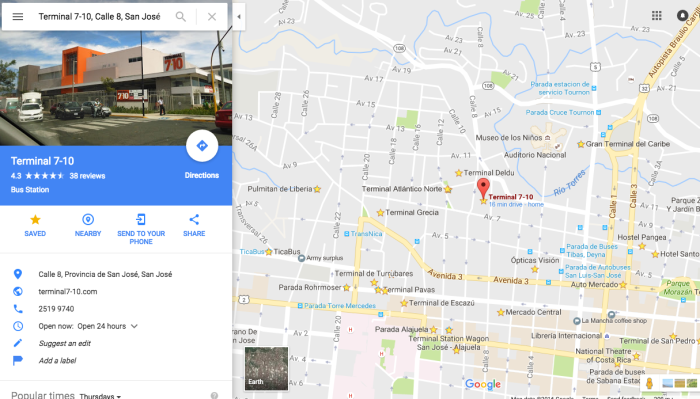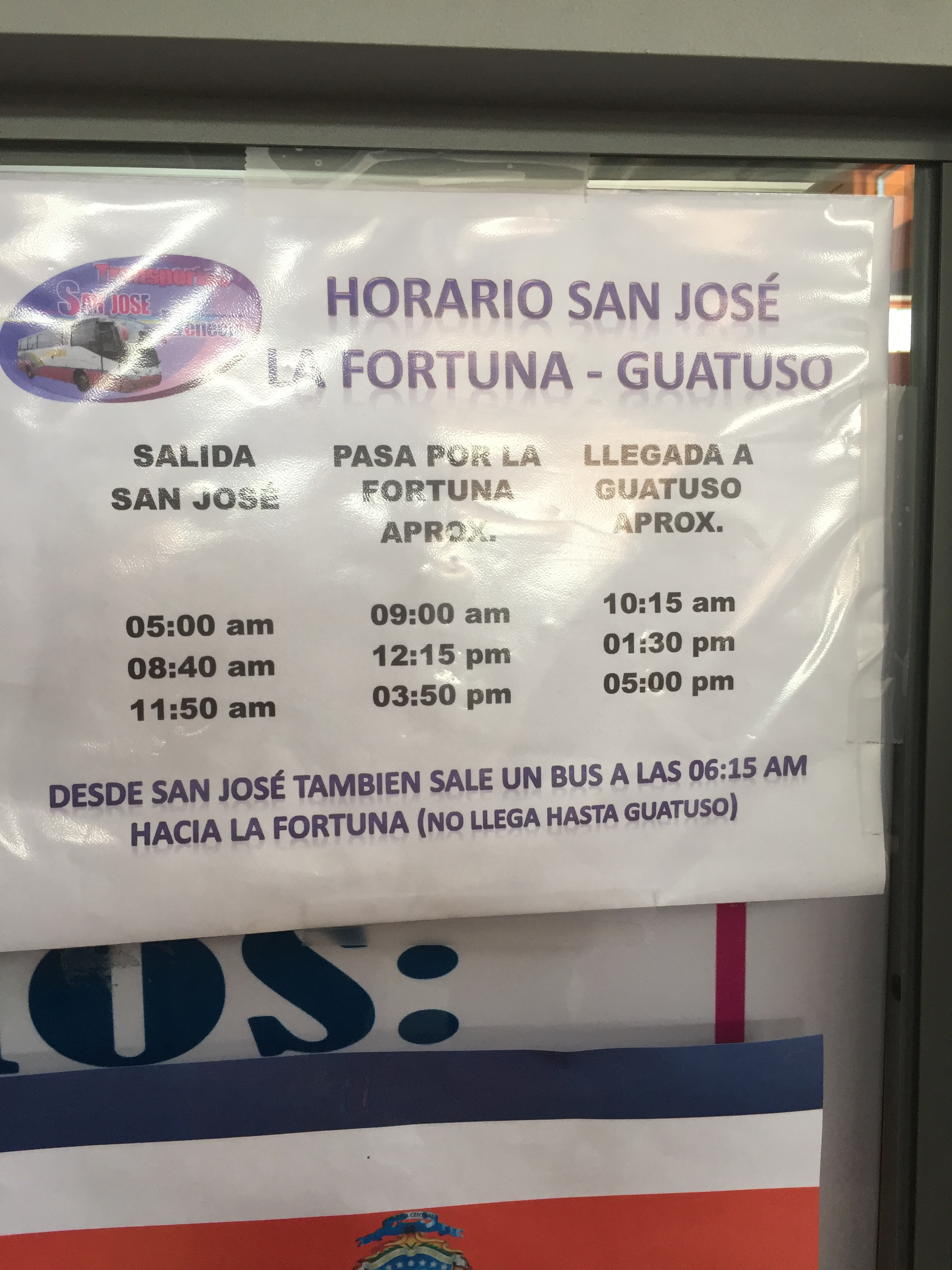One of the annual events my wife and I are starting to enjoy is a visit to La Fortuna (LF) during the low season in September, which is also the green or rainy season. September and October are two of the rainiest months in CR, which means there are fewer people and better deals. In 2015, we took the bus from San Ramon to La Fortuna for a couple of days of R&R link. The inexpensive bus from San Ramon to LF runs four times a day and provides quite a scenic ride; however, if you tend to experience motion-sickness, I recommend you take a Dramamine tablet when you board the bus. We stayed in a hotel for $30 a night and took a few adventure tours which were half the usual high-season rates. So we enjoyed a $35 half-price guided tour of Arenal. At the end of the tour, the sky opened up and we experienced the full force of mother nature and were drenched. We learned from that experience that the rain is not all that bad and we could live with it for the discounted prices being offered. We also learned there was a free hot spring enjoyed by the locals and budget minded Free Hot Springs in La Fortuna.
So in September of 2016, we wanted to celebrate our 35th wedding anniversary and decided to explore the hot springs in LF. I have been collecting all the Hot Springs in Costa Rica locations so we can eventually try them all. You might enjoy reading this review of The best hot springs in La Fortuna.
There are about eight hot springs in LF, so we chose two high-end places – Tabacon and Eco Termales. Tabacon is a high-end, tourist experience and Eco Termales is a smaller, more intimate experience.
Step 1: Terminal 7-10
The first step in any CR bus adventure is finding the right bus station. There are many bus stations in San Jose – normally one for each bus company and route. Terminal 7-10 is new and fortunately has a number of bus companies located in the facility, which is also a shopping mall with stores, a pharmacy, and a food court.
We always take a taxi to the station because the area has a reputation for being dicey. The area between Terminal 7-10 and the central avenue is known as the “red zone” and, in addition to having many hourly hotels, has many homeless and drug users and is best avoided on foot.

Here is a Facebook Album of Terminal 7-10 with photos link and here is where to eat link.
On the third floor, go the ticket station on the left end (there is another bus company to the right), and buy your ticket to La Fortuna from the window on the far right of the counter.


I bought my ticket a few days before because I am risk-averse; however, except for holidays, you can probably show up an hour beforehand and buy a ticket without a problem. There are three buses a day going to La Fortuna from San Jose. I purchased the 8:40 a.m. bus.

An alternate route, shown below, is to take the bus from San Jose to Ciudad Quesada and from Ciudad Quesada to La Fortuna, which runs frequently.

BTW, I typically type out the information for the ticket I want to buy so there are no misunderstandings. Remember that Costa Rica’s date format is DD/MM/YYYY so I normally write it out (ex: September 26, 2016) and the day of the week (Monday) with the Spanish translation to reduce the chance for error. The bus ticket to LF costs about $5 USD. You get a white ticket which you give the driver and a yellow copy for your records. In addition, the driver will give you a temporary ticket to re-board at the midway rest stop.

Step 2: The Bus Trip
The phone app, Map.Me, which I use to follow the trip, indicated the trip would take about two hours, not accounting for traffic or stops. We left at 8:40 a.m. and arrived at 1 p.m., so the duration was more like four hours. There are no bathrooms on the bus, which has only one rest stop halfway through the trip (at Ciudad Quesada), so use the bathrooms on the 2nd and 3rd floor of Terminal 7-10 before you leave. The attendant charges c200.

Note: if you have a seat preference, there is no reserved seating on this route and the bus boards 15 minutes before leaving.
Also, this bus does not have AC, so if you need air, get on early to find a seat with a window that will open. Once you are seated is a good time to take that Dramamine if you need it. I sat on the right side hoping to get better views, which proved correct. I was excited that my backpack fit in the overhead (photo below) since many times the overhead space is very tight and I have to keep my backpack between my legs the whole trip, which would not have been good on this route given how tightly the seats are spaced. I always put my backpack across from me so I can keep an eye on it. The driver put all the big luggage under the bus and gave people a luggage receipt, which was reassuring.

The bus left at 8:44 a.m. and was probably 1/4 full. You give the driver the white receipt and keep the yellow copy. Something different this time was the driver handed me the plastic card below to use to get back on the bus at the midway rest stop at Ciudad Quesada, so don’t lose it. Warning: the rest stop is only 10 minutes and not everyone will get off; also, if you don’t get back in time, new riders will be lined up and may take your seat, so get back in time to reclaim your seat and don’t leave valuables behind.
.
I plotted the bus route and stops here link. Most notable: the bus stopped in Alajuela (Central de Autobuses del Norte) across the highway from SJO airport. If you fly in and want to avoid coming into San Jose ($30 taxi ride) to board where the bus starts, you can board in Alajuela. Warning: since there are no reserved seats, there is a possibility you could be standing for four hours!
What I find so fascinating about Costa Rica are the changes in elevation and the resulting weather pattern. To understand the graph on the elevation map below from Google Earth, read from left to right to follow our trip from San Jose to La Fortuna. The trip starts at 38oo ft. above sea level in San Jose, dips down by Alajuela and then heads higher going north into the cloud forest. Around Naranjo, you can feel the temperature drop. Interestingly, the elevation drops under 1000 ft. when you get to La Fortuna (right side of graph below) which means it is hotter than I like. I prefer life above 3000 feet, which is normally 70F (+/- 10 degrees) most of the time.

The bus stops in Zarcero, which has a beautiful central park full of topiary arches, so look right. It could be a final destination for anyone wanting to explore this pretty town.
Facebook album of Zarcero photo link.
Step 3: La Fortuna Bus Station
Here are some pictures from the La Fortuna Facebook Album link.
The La Fortuna bus station is modern, small, safe, clean and easy to navigate.
Note: attached to the bus station is a MegaSuper, a full grocery store where you can buy your supplies before heading to the hostel or trail.
If you want to go around the lake, this station has a bus going to Tilaran on the west side of the lake.
Another great feature of this station is the soda (small restaurant) located near the bus station just past the MegaSuper. Soda La Hormiga has a clean bathroom, a wide selection and reasonable prices. Soda Website. It is only open for breakfast and lunch.
Here are some hot springs ideas: Tabacon (expensive) to Free Hot Springs in La Fortuna (cheap).
Step 3: Getting back to San Jose
When the time comes to return to San Jose, Tyler Wenzel at CRTravel wrote up the details here La Fortuna to San Jose Return Trip. The bus returning to San Jose stops at SJO airport in case you are flying out.












